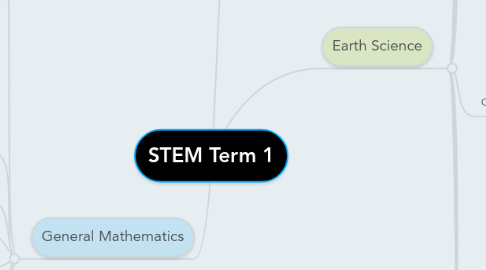
1. General Mathematics
1.1. Functions
1.1.1. Rational Functions
1.1.1.1. Discontinuities
1.1.1.2. Vertical Asymptote
1.1.1.3. Horizontal Asymptote
1.1.1.4. Oblique Asymptote
1.1.1.5. EX. y=2x + 5 / x - 1
1.1.2. Rational Inequality
1.1.2.1. EX. f(x) = x + 3 / x - 2 = 0
1.1.3. Inverse Functions
1.1.3.1. EX. f^(-1) = 3x + 2
1.1.4. Exponential Functions
1.1.4.1. EX. 3^2x - 5 = 3^x + 3
1.1.5. Exponential Inequality
1.1.5.1. EX. 5^x - 4 > 625
1.1.6. Logaritmic Functions
1.1.6.1. Common Logarithm
1.1.6.2. EX. log(x) = 2 - log(x)
1.1.6.3. Natural Logarithm
1.1.6.4. EX. 2ln(x+2) - ln(-x) = 0
1.1.7. Logarithmic Inequality
1.1.7.1. ln(x^2 - 1) >= 5
1.1.8. Domain and Range
1.1.9. Operations on Functions
1.2. Linear and Non-linear Equations
1.2.1. Elimination Method
1.2.2. Substitution Method
1.3. Simple Interest
1.3.1. FORMULA: I = PRT
1.4. Compound Interest
1.4.1. FOMULA: F = P(1 + j/m)^tm
1.5. Ordinary Annuity
1.5.1. FORMULA: F = R((1 + i)^n - 1/ i)
1.6. Deferred Annuity
1.6.1. FORMULA: P = R((1 - (1 + i)^-n / i) (1+ i)^-d
1.7. General Annuity
1.7.1. i2 = (1 + i)^c - 1
1.8. Amortization
1.8.1. FORMULA: R = Pi / 1 - (1 + i)^-n
1.9. Logic
1.9.1. Logical Operation
1.9.1.1. Negation
1.9.1.2. Conjunction
1.9.1.3. Disjunction
1.9.1.4. Exclusive
1.9.1.5. Implication
1.9.1.6. Biconditional
1.9.2. Methods of Deduction
1.9.2.1. Addition
1.9.2.2. Simplification
1.9.2.3. Conjunction
1.9.2.4. Modus Ponens
1.9.2.5. Modus Tollens
1.9.2.6. Hypothetical Syllogism
1.9.2.7. Disjunctive Syllogism
1.9.3. Conditional Propositions
1.9.3.1. Tautology
1.9.3.2. Contradiction
1.9.3.3. Contingency
2. Empowerment Technologies
2.1. Canvas
2.2. ICT
2.2.1. Impact of ICT
2.2.2. Trends of ICT
2.3. Cybercitizenship
2.4. Research
2.4.1. Using Internet for Research
2.4.2. Refining Search Queries
2.4.3. Cite References
2.5. MS Excel
2.5.1. Keyboard Shortcuts
2.5.2. Formulas
2.6. GIMP
2.7. MS Word
2.7.1. Templates
2.8. MS Powerpoint
2.8.1. Rules
2.9. Mind Mapping
2.10. Security
3. Earth Science
3.1. Earth and Space
3.1.1. Old and New Ideas
3.1.1.1. Geocentric
3.1.1.2. Heliocentric
3.1.2. Galaxies
3.1.2.1. Big Bang theory
3.1.3. Stars
3.1.3.1. Sun
3.1.3.1.1. Sunspot Cycle
3.1.3.1.2. Solar Wind
3.1.3.2. Wavelength
3.1.4. Planets
3.1.4.1. Jovian
3.1.4.2. Terrestrial
3.1.4.2.1. Earth
3.1.4.3. Definition of a Planet
3.2. Plate Tectonics
3.2.1. Conntinental Drift
3.2.1.1. Matching Features
3.2.1.2. Paleoclimates
3.2.2. Evidence from Seafloor
3.2.2.1. Seafloor Topography
3.2.2.1.1. Continental Shelf
3.2.2.1.2. Abyssal Plain
3.2.2.1.3. Oceanic Trench
3.2.2.1.4. Oceanic Trench
3.2.2.2. Age of Seafloor
3.2.2.3. Heat Flow
3.2.2.4. Volcanoes
3.2.3. Seafloor Spreading Hypothesis
3.2.3.1. Magnetic Field
3.2.3.1.1. Direction
3.2.3.1.2. Inclination
3.2.3.1.3. Paleomagnetism
3.2.3.1.4. Normal Polarity
3.2.3.1.5. Reverse Polarity
3.2.4. Earthquakes
3.2.4.1. Plates of the World
3.2.4.1.1. African, Antarctic, Eurasian, Indian-Australian, Nazca, Pacific, North and South American
3.2.5. Partial Melting of Rocks
3.2.5.1. Increase in Temperature
3.2.5.2. Decrease in Pressure
3.2.5.3. Addition of Water
3.2.6. Plate Movement
3.2.6.1. Away from subduction zones
3.2.7. Plate Boundaries
3.2.7.1. Divergent
3.2.7.1.1. plates move apart
3.2.7.2. Convergent
3.2.7.2.1. plates move toward each other
3.2.7.2.2. kinds of convergent boundary
3.2.7.3. Transform
3.2.7.3.1. plates slide past each other
3.3. Earthquakes
3.3.1. Faults
3.3.1.1. Normal
3.3.1.2. Reverse
3.3.1.3. Strike Slip
3.3.2. Seismic Waves
3.3.2.1. Surface Waves
3.3.2.1.1. Rayleigh Waves
3.3.2.1.2. Love Waves
3.3.2.2. Body Waves
3.3.2.2.1. P Waves
3.3.2.2.2. S Waves
3.3.3. Magnitude
3.3.4. Intensity
3.4. Volcanoes
3.4.1. Magma
3.4.1.1. Basaltic
3.4.1.2. Andesitic
3.4.1.3. Rhyolitic
3.4.2. Volcanoes
3.4.2.1. Shield
3.4.2.2. Stratovolcano
3.4.2.3. Cinder Cone
3.5. Rocks and Minerals
3.5.1. Rock Formation
3.5.1.1. Neptunism
3.5.1.2. Plutonism
3.5.2. Characteristics
3.5.2.1. Crystal Form
3.5.2.2. Cleavage
3.5.2.3. Hardness
3.5.2.4. Color
3.5.2.5. Luster
3.5.2.6. Streak
3.5.3. Types of Rocks
3.5.3.1. Igneous
3.5.3.1.1. Volcanic
3.5.3.1.2. Plutonic
3.5.3.2. Sedimentary
3.5.3.2.1. Clastic
3.5.3.2.2. Chemical
3.5.3.2.3. Biochemical
3.5.3.3. Metamorphic
3.5.3.3.1. Regional Metamorphism
3.5.3.3.2. Contact Metamorphism
3.5.4. Rock Cycle
3.6. Geologic Time
3.6.1. Relative Time
3.6.1.1. Principles
3.6.1.1.1. Superposition
3.6.1.1.2. Cross Cutting Relationships
3.6.1.1.3. Inclusion
3.6.1.2. Deductions by Hutton
3.6.1.2.1. Uniformitarianism
3.6.1.2.2. Unconformities
3.6.1.3. Fossils
3.6.1.3.1. Trace Fossil
3.6.1.3.2. Index Fossil
3.6.2. Geologic Time
3.6.2.1. Time Scale
3.6.2.1.1. Pre Cambrian
3.6.2.1.2. Paleozoic
3.6.2.1.3. Mesozoic
3.6.2.1.4. Cenozoic
3.6.3. Numerical Time
3.6.3.1. Isotopes
3.6.3.2. Radioactive Decay
3.6.3.3. Half life
3.7. Weathering and Soil
3.7.1. Weathering
3.7.1.1. Physical Weathering
3.7.1.1.1. Unloading
3.7.1.1.2. Wedging
3.7.1.2. Chemical Weathering
3.7.1.2.1. Dissolution
3.7.1.2.2. Hydrolysis
3.7.1.2.3. Oxidation
3.7.1.3. Biological
3.7.1.3.1. Macroscopic
3.7.1.3.2. Microscopic
3.7.1.4. Controls Weathering
3.7.1.4.1. Rock Composition
3.7.1.4.2. Rock Properties
3.7.1.4.3. Climate
3.7.2. Soils
3.7.2.1. Layers
3.7.2.1.1. Surface Layer
3.7.2.1.2. Topsoil
3.7.2.1.3. Subsurface
3.7.2.1.4. Parent Material
3.7.2.1.5. Bedrock
3.7.2.2. Formation
3.7.2.2.1. Rock in source area
3.7.2.2.2. Temperature and amount of rain
3.7.2.2.3. Biological activity
3.8. Slope Failure
3.8.1. Mass Wasting
3.8.1.1. Factors
3.8.1.1.1. Steep slopes
3.8.1.1.2. Water
3.8.1.1.3. Cohesion
3.8.1.1.4. Human Activity
3.8.1.1.5. Gravity
3.8.2. Landslide Processes
3.8.2.1. Rockfall
3.8.2.2. Rockslide
3.8.2.3. Slump
3.8.2.4. Creep
3.8.2.5. Debris Flow
3.9. Atmosphere
3.9.1. Layers
3.9.1.1. Troposphere
3.9.1.2. Stratosphere
3.9.1.3. Mesosphere
3.9.1.4. Thermosphere
3.9.1.5. Exosphere
3.9.2. EMR (Electromagnetic Radiation)
3.9.2.1. Scattered
3.9.2.2. Reflected
3.9.2.3. Absorbed
3.10. Weather
3.10.1. affected by
3.10.1.1. Wind
3.10.1.1.1. Land and Sea Breeze
3.10.1.1.2. Upslope and Downslope Wind
3.10.1.1.3. Chinook Wind
3.10.1.1.4. Santa Ana Wind
3.10.1.2. Pressure
3.10.1.2.1. High Pressure
3.10.1.2.2. Low Pressure
3.10.1.3. Fronts
3.10.1.3.1. Cold Front
3.10.1.3.2. Warm Front
3.10.1.3.3. Stationary Front
3.10.1.3.4. Occluded Front
3.10.1.4. Air mass
3.10.1.4.1. Maritime Polar
3.10.1.4.2. Maritime Tropical
3.10.1.4.3. Continental Tropical
3.10.1.4.4. Continental Polar
3.10.1.5. Clouds
3.10.1.5.1. Formation
3.10.1.5.2. Types
3.10.1.6. Precipitation
3.10.1.6.1. Liquid
3.10.1.6.2. Freezing
3.10.1.6.3. Frozen
3.11. Weather Systems
3.11.1. Midlatitude Cyclone
3.12. Severe Weather
3.12.1. Thunderstorm
3.12.1.1. Lightning
3.12.1.1.1. Cloud to ground
3.12.1.1.2. Cloud to cloud
3.12.2. Tornado
3.12.3. Hurricane
